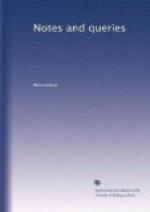To cure Warts, the following charm is used:—A wedding-ring is procured, and the wart touched or pricked with a gooseberry thorn through the ring.
To cure Epilepsy, take three drops of sow’s milk.
To cure Blisters in a cow’s mouth, cut the blisters; then slit the upper part of the tail, insert a clove of garlic, and tie a piece of red cloth round the wound.
To cure the Murrain in Cows.—This disease is supposed to be caused by the cow having been stung about the mouth while feeding, in consequence of contact with some of the larger larvae of the moth (as of the Death’s-head Sphynx, &c.), which have a soft fleshy horn on their tails, erroneously believed to be a sting. If a farmer is so lucky as to procure one of these rare larvae, he is to bore a hole in an ash tree, and plug up the unlucky caterpillar alive in it. The leaves of that ash tree will, from thenceforth, be a specific against the disease.
The universal prevalence of the superstition concerning the ash is extremely curious.
J.G.
Kilkenny. {350}
Death-bed Superstition.—See Guy Mannering, ch. xxvii. and note upon it:—
“The popular idea that the protracted struggle between life and death is painfully prolonged by keeping the door of the apartment shut, was received as certain by the superstitious eld of Scotland.”
In my country (West Gloucestershire) they throw open the windows at the moment of death.
The notion of the escape of the soul through an opening is probably only in part the origin of this superstition. It will not account for opening all the locks in the house. There is, I conceive, a notion of analogy and association.
“Nexosque et solveret artus,” says Virgil, at the death of Dido. They thought the soul, or the life, was tied up, and that the unloosing of any knot might help to get rid of the principle, as one may call it. For the same superstition prevailed in Scotland as to marriage (Dalyell, p. 302.). Witches cast knots on a cord; and in a parish in Perthshire both parties, just before marriage, had every knot or tie about them loosened, though they immediately proceeded, in private, severally to tie them up again. And as to the period of childbirth, see the grand and interesting ballad in Walter Scott’s Border Poems, vol. ii. p. 27., “Willye’s Lady.”
C.B.
* * * * *
NOTE ON HERODOTUS BY DEAN SWIFT.
The inclosed unpublished note of Dean Swift will, I hope, be deemed worthy of a place in your columns. It was written by him in his Herodotus, which is now in the library of Winchester College, having been presented to it in 1766, by John Smyth de Burgh, Earl of Clanricarde. The genuineness of the handwriting is attested by a certificate of George Faulkner, who, it appears, was well qualified to decide upon it. The edition is Jungerman’s, folio, printed by Paul Stephens, in 1718.




